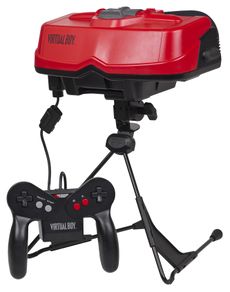Virtual Boy
[[File: |230px]] |230px]]
| |
| Manufacturer | Nintendo |
|---|---|
| Generation | Fifth generation |
| Release date | July 21, 1995 (JP) August 14, 1995 (NA) |
| Media type | Game Pak ROM cartridge |
The Virtual Boy (バーチャルボーイ) was a table-top video game console developed and manufactured by Nintendo. It was the first video game console that was supposed to be capable of displaying "true 3D graphics" out of the box, in a form of virtual reality. Whereas most video games use monocular cues to achieve the illusion of three dimensions on a two-dimensional screen, The Virtual Boy creates an illusion of depth through the effect known as parallax. In a manner similar to using a head-mounted display, the user looks into an eyepiece made of neoprene on the front of the machine, and then an eyeglass-style projector allows viewing of the monochromatic (in this case, red) image.
Hardware Specifications[edit]
| Technical Specifications | |
|---|---|
| Processor | Customized NEC V810 (P/N uPD70732) 32-bit RISC Processor @ 20 MHz (18 MIPS) 1 KB instruction cache |
| Memory | 128 KB of DRAM 64 KB WRAM (PSRAM) |
| Video | 128 KB dual-port VRAM |
| Display x2 |
|
| Audio | 16-bit Stereo |
| Controller | 6 buttons & 2 D-pads |
| I/O ports | Serial Port (8 pin cable) NES controller protocol |
| Media | Game Pak ROM Cartridge |
| Weight | 750 grams |
| Dimensions | 8.5"H × 10"W × 4.3"D |
| Power |
|
Cartridge[edit]
The Virtual Boy uses 60-pin cartridges which connect to the console through a series of needle-like pins instead of a typical cartridge slot with flat contacts. Unlike cartridges for most other consoles, the ROM chip in a Virtual Boy cartridge does not sit on the label side of the board.

